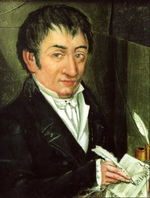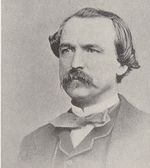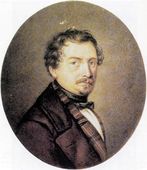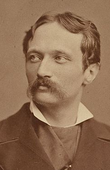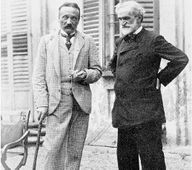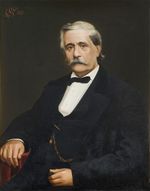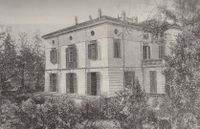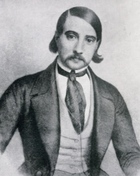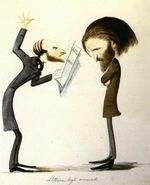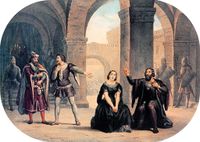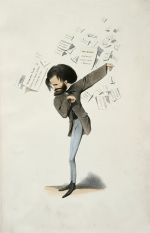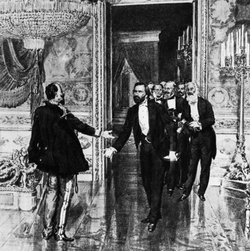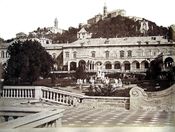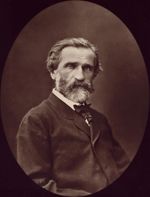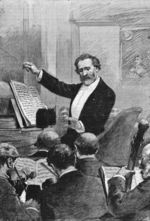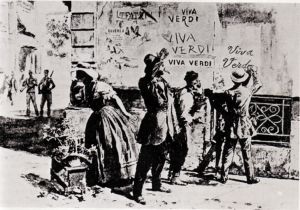جوزپى ڤردي
| جيوسپي ڤردي | |
|---|---|
| بوررتريه لجيوسپي ڤردي من أعمال جيوڤاني بولديني عام 1886
| |
| الميلاد | 10 أكتوبر 1813 رونكولي، إيطاليا |
| الوفاة | 27 يناير 1901 ميلانو، إيطاليا |
| جوسپه ڤردي |
|---|
 |
جيوسـِپّي ڤـِردي (Giuseppe Verdi) عاش (و.1813 رونكولي - 1901 ميلانو) هو مؤلف موسيقي إيطالي. ألف العديد من الأعمال الأوبرالية (على غرار عايدة وعُطيل)، كما كتب قُداسا جنائزيا (Requiem) عام 1874م. كان له حِس طبيعي أهله لكتابة الأعمال المسرحية، عمل على مواصلة مسيرة مواطنيه "بليني" و "روسيني" في ترسيخ التقاليد الأوبرالية الإيطالية في مواجهة التيار الجديد المتأثر بأعمال "ريتشارد ڤاگنر".
ويعد أحد أبرز مؤلفي الأوبرا الإيطاليين في القرن التاسع عشر الميلادي. تؤدى أعماله في الوقت الحاضر أكثر من أعمال أي مؤلف أوبرا آخر. أنتج فيردي في الفترة 1851 - 1871م سلسلة من الروائع تشتمل على ريغوليتو (1851م)؛ التروفاتوري (1853م)؛ لاترافياتا (1853م)؛ صلاة المساء الصقلية (1855م)؛ سايمون بوشانيفرا (1857م)؛ تم تنقيحها (1881م)؛ حفلة تنكرية (1859م)؛ لافورزا دل دستينو (1862م)؛ دون كارلوس (1867م)؛ عايدة (1871م) التي ألفها لمناسبة الاحتفال بفتح قناة السويس. ألف فيردي 25 أوبرا وكتب نصوص كل أعماله الأوبرالية بالإيطالية ماعدا أوبرا صلاة المساء الصقلية، ودون كارلوس اللتين كتب نصوصهما بالفرنسية.
اكتسب فيردي شهرة عالمية وذلك لبراعته الفائقة في التأثير المسرحي، خصوصًا الألحان المليئة بالحياة والنابضة بالحيوية التي تتميز بها أعماله الأوبرالية. أخذ الكثير من حبكة أعماله الأوبرالية من مسرحيات دراميين مشهورين مثل فيكتور هوجو وفريدريش شيلر ووليم شكسبير. وكتب فيردي ألحانا كثيرة لفنانين اشتهروا بتميّزهم في الغناء الفردي، كما كتب لمجموعات صغيرة من المغنين. أصبحت جوقته الأوبرالية مشهورة في كل أنحاء العالم.
أصبح فيردي الوطني الثائر والغيور على بلاده رمزًا لكفاح إيطاليا لأجل استقلالها عن النمسا في منتصف القرن التاسع عشر الميلادي، فقد كان في صراع دائم مع السلطات النمساوية لشعورها بأن أعماله الأوبرالية تُذْكي الحس القومي عند الإيطاليين. وقد أصبحت موسيقى أعماله الأوبرالية، خصوصًا موسيقى أوبرا نابوشو وأوبرا اللومباردي شعارًا للحركة الوطنية الإيطالية .
. . . . . . . . . . . . . . . . . . . . . . . . . . . . . . . . . . . . . . . . . . . . . . . . . . . . . . . . . . . . . . . . . . . . . . . . . . . . . . . . . . . . . . . . . . . . . . . . . . . . . . . . . . . . . . . . . . . . . . . . . . . . . . . . . . . . . . . . . . . . . . . . . . . . . . . . . . . . . . . . . . . . . . . .
حياته
The early years: Le Roncole, Busseto and Milan
ولد فيردي في لورونكول بالقرب من پارما. ودرس الموسيقى وهو صبي في بوزيتو (مدينة قريبة من موطنه). وحاول في عام 1832م الالتحاق بمعهد الموسيقى في ميلان ولكن طلبه رُفِض لكبر سنه ولافتقاره للتدريب الأكاديمي الكافي، فبدأ في أخذ دروس خصوصية في ميلان .
1820 to 1832: Musical education in Busseto
1832 to 1834: Musical education in Milan

1834 to 1839: Return to Busseto
Beginnings as an opera composer
1839 to 1840: Return to Milan; first opera, Oberto
لاقت أوبراه الأولى أوبيرتو، نجاحا منقطع النظير في عرضها الأول في لاسكالا (دار الأوبرا الأولى في ميلان) وكان ذلك في عام 1839م. وماتت زوجته الأولى واثنين من أطفاله في الفترة 1838 - 1840م. لكن المؤلف المفعم بالأسى والحزن والحسرة استطاع كتابة أوبرا كوميدية سماها أون جيورنو دي ريغنو لم يحالفها النجاح عند عرضها عام 1840م.
Nabucco
Nabucco (9 March 1842, La Scala, Milan). After the failure of Giorno, Verdi vowed never to compose again, but in "An Autobiographical Sketch" written in 1879, he tells the story of how Merelli twice persuaded him to write a new opera.[1] However, the distance of 38 years may have led to a somewhat romanticized view (or, as Julian Budden puts it: "he was concerned to weave a protective legend about himself [since] it was all part of his fierce independence of spirit".)[2]
ولكن أوبراه الثالثة نابوكو، أهلته أن يكون في مقدمة مؤلفي الأوبرا في ذلك الوقت.
1844 to 1846: Busseto and Milan; Commissions from Rome, Milan, Naples, and Venice
The beginning of Verdi's and Muzio's years together
- Verdi's librettists
. . . . . . . . . . . . . . . . . . . . . . . . . . . . . . . . . . . . . . . . . . . . . . . . . . . . . . . . . . . . . . . . . . . . . . . . . . . . . . . . . . . . . . . . . . . . . . . . . . . . . . . . . . . . . . . . . . . . . . . . . . . . . . . . . . . . . . . . . . . . . . . . . . . . . . . . . . . . . . . . . . . . . . . .
1845: Verdi becomes a landowner
1846 to 1847: Milan, then Macbeth for Florence
Verdi's period of rest and recovery in Milan
June 1847 to July 1849: Verdi in London and Paris
Operas for London, Paris, and Trieste
Verdi's relationship with Giuseppina Strepponi
April 1848: Verdi and the Risorgimento
The "Cinque Giornate": Verdi hurries to Milan; then Busseto
July 1849: Verdi and Strepponi return to Italy
1849 to 1859: Verdi's "Middle Period"
The music of the "Middle Period"
. . . . . . . . . . . . . . . . . . . . . . . . . . . . . . . . . . . . . . . . . . . . . . . . . . . . . . . . . . . . . . . . . . . . . . . . . . . . . . . . . . . . . . . . . . . . . . . . . . . . . . . . . . . . . . . . . . . . . . . . . . . . . . . . . . . . . . . . . . . . . . . . . . . . . . . . . . . . . . . . . . . . . . . .
July 1849 to May 1851: Verdi and Strepponi at the Palazzo Dordoni
May 1851 forward: Verdi and Strepponi at Sant'Agata
The "Galley Years": operas from Luisa Miller to La traviata

1853 to 1859, the "Galley Years" come to an end
December 1855 to July 1856: Return to Sant'Agata
1857: Return for a year of tranquil country life
Early 1858 to February 1859: Naples and Rome for the final "Galley Year"
Verdi and Strepponi marry
Giuseppina had given a hint of their plans in her letter to De Sanctis of 21 May: Writing to him she gave affectionate greetings to [my godson Giuseppe and his mother] and then wrote "Teach them to say 'Peppina Verdi' this autumn".[3]
The operas from Les vêpres siciliennes to Un ballo in maschera
Les vêpres siciliennes: (13 June 1855, The Opéra, Paris) Scribe missed his July 1853 deadline, and Verdi went to Paris to negotiate directly, the solution being that a revised version of Le duc d'Albe (originally written for Donizetti) would be used in place of an original subject.[4] However, Le duc was an opera written about 20 years before and very much out of date by then. Verdi demanded a "standard" fifth act to make it a true grand opera.[5]
1862 to 1893: The "Late period"
The operas of the "Late Period"
Late 1859 to 1862: Return to living at Sant'Agata
Verdi enters Italian politics
1861: Verdi agrees to compose for St Petersburg
1867 forward: Verdi and Strepponi winter in Genoa
The last compositions

Last years
Role in the Risorgimento

وبعد إنجازه لأوبرا عايدة عام 1871م، قرر فيردي اعتزال التأليف، وكان ذلك بسبب الشيخوخة والمرض. ولم يقدم فيردي عملاً مهمًّا سوى قداس راحة الموتى الذي كتبه تخليدًا لذكرى المؤلف الإيطالي ألساندرو مانزوني، وذلك في الأعوام الستة عشر التي تلت قرار اعتزاله.
عاد فيردي إلى التأليف مرة أخرى في منتصف ثمانينيات القرن التاسع عشر الميلادي، وذلك استجابة لطلب كريم من صديقه أريغو بويتو وهو شاعر ومؤلف موسيقى إيطالي. شارك بويتو بكتابة نص عطيل فيردي (1887م)، وفالستاف (1893م) اللتين لحنهما فيردي. والواقع أن كثيرًا من النقاد نظروا إلى أوبرا عطيل باعتبارها أعظم أوبرا تراجيدية. وقد اعتبرها بعضهم أعظم أوبرا إيطالية على الإطلاق. وفالستاف هي ثاني أوبرا كوميدية ألفها فيردي، وهي تعتبر أيضًا أفضل عمل كوميدي عرفه البشر.
وفي عام 1893 ألف جوسپه ڤردي آخر اوپراته، الكوميديا الغنائية فالستاف، مع ليبرتو من تأليف أريگو بويتو وهو مبني على رواية وليام شيكسپير زوجات ونزر المرحات، تلقى نجاحاً باهراً في عرضها الأول في مسرح لا سكالا في ميلانو.
وفي عام 1898م، قام فيردي بتأليف أربعة مؤلفات دينية بعد فالستاف سماها رباعية بيزي ساكري. وقد أعلنت فترة حداد قومي في إيطاليا عند وفاة فيردي. وجمع تشارلس أوزبورن كل أعمال فيردي في كتاب سماه أعمال فيردي الأوبرالية الكاملة. وقام أوزبورن في هذا الكتاب بتحليل تاريخي أدبي وموسيقي لعناصر أعمال فيردي الأوبرالية.
من أعماله الأوبرالية

هل لديك مشكلة في تشغيل هذا الملف؟ انظر مساعدة الوسائط.

هل لديك مشكلة في تشغيل هذه الملفات؟ انظر مساعدة الوسائط.

هل لديك مشكلة في تشغيل هذه الملفات؟ انظر مساعدة الوسائط.

هل لديك مشكلة في تشغيل هذا الملف؟ انظر مساعدة الوسائط.
- ريگوليتو (1851م)؛
- الصلوات المسائية الصقلية (1855م)؛
- الحفل المُقنع (1859م)؛
- دون كارلوس (1867م)؛
- عايدة (1871م)، والتي ألفها مأجوراً من الخديوي اسماعيل.
- عطيل (1887م)؛
- نابوكو وهي اختصار لكلمة نبوخذ نصر، التي اشتهر منها نغمة ڤا، پنسييرو التي أنشدها كورس العبيد اليهود.
Legacy
Verdi has been the subject of a number of cultural works. These include the 1938 film directed by Carmine Gallone, Giuseppe Verdi, starring Fosco Giachetti; the 1982 miniseries, The Life of Verdi, directed by Renato Castellani, where Verdi was played by Ronald Pickup, with narration by Burt Lancaster in the English version; and the 1985 play After Aida (a play-with-music similar to Amadeus). He is a character in the 2011 opera Risorgimento! by Italian composer Lorenzo Ferrero, written to commemorate the 150th anniversary of Italian unification of 1861.
There are three music conservatories, the Milan Conservatory and those in Turin and Como, and many theatres named after Verdi in Italy. There is a Giuseppe Verdi Monument in Verdi Square in Manhattan, in the USA.
The International Astronomical Union named a relatively young impact crater on the planet Mercury after Verdi in 1979 [6] which is sometimes called "Joe Green" by NASA.[7]
In sculpture
Carlo Nicoli’s bust of Verdi was erected in Tower Grove Park in Saint. Louis in 1887.[8]
The Giuseppe Verdi Monument a marble monument in his honor is located in Verdi Square in Manhattan, New York City. The statue, which includes a statue of Verdi and well as life-sized statues of four of his well known characters, Aida, Otello, Falstaff, and Leonora, was dedicated on 11 October 1906 was by Pasquale Civiletti. [9]
Philadelphia’s Fairmount Park is the home on G.B.Bashanellifuso’s bust of Verdi, "a gift of the Italian Colony of Philadelphia to the city in 1907."[10]
See also
- The Life of Verdi, a 1982 television miniseries
== المراجع ==Notes
- ^ Verdi, "An Autobiographical Sketch" 1879 in Werfel and Stefan 1973, pp. 87–92
- ^ Budden 1973, p. 92
- ^ خطأ استشهاد: وسم
<ref>غير صحيح؛ لا نص تم توفيره للمراجع المسماةStoD - ^ Parker 1992, pp. 924–925
- ^ Letter from Verdi to Scribe, Budden 1984, pp. 173–174
- ^ "Nomenclature: Mercury, craters". IAU. Retrieved 20 May 2013.
- ^ "Meet Joe Green". NASA. Retrieved 20 May 2013.
- ^ McCue, George, Sculpture City:St. Louis, photograph by David Finn and Amy Binder, Hudson Hills Press, NY in association with Laumeier Sculpture Park, St. Louis, 1988 p. 45
- ^ Full details of the monument on the Smithsonian Institution website
- ^ Fairmount Park Art Association, Sculpture if a City: Philadelphia’s Treasures in Bronze and Stone Walker Publishing Co., Inc. New Your, 1974 p227
وصلات خارجية
General
Lists of operas
- List of Verdi operas, premiere locations and dates prepared by Stanford University
- National Museum Giuseppe Verdi - Busseto
- Works by or about جوزپى ڤردي at Internet Archive
Libretti and scores
- Digitised collection of Verdi libretti and scores collected by music bibliographer Cecil Hopkinson at National Library of Scotland
Modern performances
Recordings
- "Album Verdi" from the Digital Library of the National Library of Naples (Italy)
- Detailed listing of complete recordings of Verdi's operas and of extended excerpts
- Verdi cylinder recordings, from the Cylinder Preservation and Digitization Project at the University of California, Santa Barbara Library
Others
- Free scores by Verdi at the International Music Score Library Project
- أعمال موسيقية مجانية من جوزپى ڤردي في مكتبة الأعمال الكورالية المشاع (ChoralWiki)
- The Mutopia Project has compositions by جوزپى ڤردي
- Parker, Roger, 'Verdi and Milan': Lecture on Verdi given at Gresham College London 14 May 2007
- 'Verdi and Milan': iPhone and iPad downloadable app about Giuseppe Verdi in Milan, created with the patronage of the Municipality and the Province of Milan
Verdi at 200
- Articles with hAudio microformats
- بذرة فنان
- جوسپه ڤردي
- مواليد 1813
- وفيات 1901
- مؤلفون موسيقيون كلاسيكيون في القرن 19
- أعضاء شرف في الجمعية الفيلهارمونية الملكية
- Italian agnostics
- Italian atheists
- مؤلفون موسيقيون كلاسيكيون إيطاليون
- Italian opera composers
- People from Busseto
- حائزو وسام الاستحقاق (الصف المدني)
- مؤلفون موسيقيون رومانسيون
- Senators of the Kingdom of Italy
- مؤلفون موسيقيون كلاسيكيون





